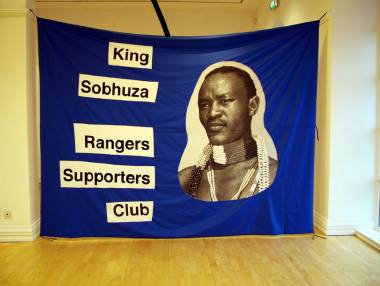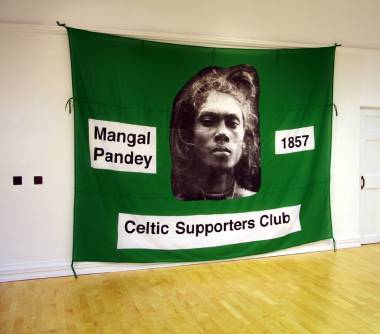Roderick Buchanan and Aisling O’Beirn were invited by curator Angela Darby to create new work contemporising the debate surrounding Ulster-Scots culture. For the uninitiated or uninterested, Ulster-Scots is an emergent movement providing a context in which some Northern Protestants can redefine their relationship to both the British and the Irish. This year Newtownards celebrated 400 years of existence, directly identifying the town’s birth with the arrival of the Scots.
Glaswegian Buchanan won the inaugural Beck’s Futures Prize and is probably best known for his sports-related videos and photographic works. O’Beirn was one of the artists who represented Northern Ireland at the ’05 Venice Biennale and she includes sculptural works, site-specific installations and urban interventions in her strategies to explore the way in which information and place can be politicised and how this politicisation is communicated.
 |
| Roderick Buchanan: King Sobhuza Rangers Supporters Club , 2006, screen-printed image and text on fabric banner. 3m x 2m; courtesy Ards Arts Centre |
Within the Ards Arts Centre, a one-time jail for a ‘player’ in the 1798 Rebellion, Buchanan presents two large works referencing football supporters’ clubs. A blue banner facing the door through which we enter the gallery contains the legend "King Sobhuza Ranger’s Supporters Club," alongside a large image of an African bedecked in columns of beads. Almost facing this image is a green banner purporting to belong to the Mangal Pandey Celtic Supporter’s Club. The portrait here is of an enigmatic Indian appearing every part as regal as the King opposite. On both banners the text and image are stitched to the coloured backings, giving an authentic, homemade finish to the works. The rivalry between Rangers and Celtic supporters is well documented, as are the broad political and religious allegiances of each group. Here Buchanan extends the symbolic resonance to include any act of rebellion or loyalty. He provides a statement detailing the significance of the two foreign individuals who have become embroidered into this local standoff.

Roderick Buchanan: Mangal Pandey Celtic Supporters Club, 2006, screen-printed image and text on fabric banner. 3m x 2m; courtesy Ards Arts Centre
Mangal Pandey was an Indian soldier of the thirty-fourth Native Infantry whose attack on a superior officer came to be recognised as the event that sparked India’s First War of Independence or the Sepoy Mutiny of 1857 depending on the allegiances of the historian recording the event. The primary motivation behind Mangal’s behavior is attributed to a new type of bullet cartridge used in the Enfield P-53 rifle introduced in the Bengal Army that year. The cartridge was rumored to be greased with animal fat (primarily pig and cow fat, which are not consumed by either Hindus or Muslims, the primary religions in the Bengal Army). The cartidges had to be bitten to remove the cover, and that was abhorrent to the soldiers. King Sobhuza ruled Swaziland during the British withdrawal from southern Africa. By remaining on diplomatic terms with the occupying force he was able to secure a bloodless liberation from British rule, though Swaziland remained within the Commonwealth, thus retaining a form of loyalty to the Crown.
These works can appear simplistic on the first reading, because of their use of such explicit cultural signifiers, I know them so well I’ve stopped seeing them. But a second reading reveals something much more interesting, to me anyway. The supporters’ clubs are of course fictitious, but the portraits of the two protagonists are likewise ‘fakes’ – they are appropriated images of two people who are imbued with the essence of the real individual’s actions. This play on the illusionary captures the false reality of all separating allegiances, whether national, religious or political. A text accompanying the exhibition by Robert Peters picks up on this theme with a series of quotes placing the transmission of sectarian ideas within Dawkins’ theory of memes, ideas as viruses. Buchanan intends to display the flags on the terraces of football matches in Scotland. It will be interesting to see if they will be adopted into the pantheon of existing symbols, shifting a localised infection into an international pandemic.
In a small room connected to the main gallery, O’Beirn projects a series of animated stories, which the artist has collected from various local sources. The stories relate the type of historical incidents that would only be known if you lived in Newtownards, an unauthorised version of social history unrelated to the actions of those in power. These tales also form the basis of two ‘Rough Guide to Newtownards’ tours, which were to be held during the run of the exhibition. Unfortunately I was not able to attend either but would have enjoyed seeing some of the landmarks mentioned, such as the Front Deed named after a successful racing Greyhound, or the Cistercian Priory which served as an unofficial crèche during the seventies.
 |
| Aisling O’Beirn: Old Cross, 2006, cardboard and brown paper; 1m diameter x 1.5m; courtesy Ards Arts Centre |
Within the same space as Buchanan’s banners, O’Beirn displays a cardboard representation of an architectural feature, locally known as The Old Cross. It is an eight-sided structure, which once served as the marker for the town centre and a vantage point from which the town crier would read proclamations from the powers that be to the peasants that were. It was seen as a symbol of allegiance to the Crown and was destroyed by Cromwell’s troops only to be rebuilt again by Protestant Royalists. After the death of James II its gargoyles served as spouts through which wine freely flowed during a three-day party; allegiance to the Crown has always been subject to variance. Like the banners, the structure has a homemade feel, a bit like a school-history project on a massive scale. Origami gargoyles are playfully attached to each corner, adding humour to the detailed form. However, the sculpture is not a true representation of the real thing; it is a version, an approximation, suited to both its material and environment. Perhaps this is the fate of all historical artefacts/ events, to be re-presented in a form that best suits present needs.
The works exhibited within the context of cultural history as a marker of present identity prove engaging and thought-provoking. If Israeli flags can be flown by loyalists in response to Palestinian flags being flown by Irish Nationalists, then perhaps Pandey and Sobhuza can take their places on the terraces and new illusions can reinforce old rivalries. Equally, the increasing importance being attached to Ulster-Scots culture may be providing new ways to maintain old divisions.
Donna Alexander is an artist and writer presently residing in Kemi, Finland.